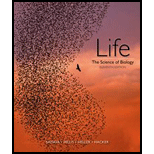
To analyze:
The ratio of purine to pyrimidine for the given set of ribonucleic acid (RNA), observation of a pattern, and the relation of this pattern to the RNA structure.
Given:
The composition of RNA is different in different organisms. The composition of RNA bases in some organisms is tabulated in Table 1 below:
Table 1: The composition of RNA bases in some organisms
|
Organism and the tissue from which RNA is extracted |
The composition of RNA base (%) | |||
| Adenine | Guanine | Cytosine | Uracil | |
| Rat liver | 19.2 | 28.5 | 27.5 | 24.8 |
| Carp muscle | 16.4 | 34.4 | 31.1 | 18.1 |
| Yeast | 25.1 | 30.2 | 20.1 | 24.6 |
| Rabbit liver | 25.1 | 30.2 | 20.1 | 24.6 |
| Cat brain | 19.7 | 26.8 | 25.8 | 27.6 |
Introduction:
The pyrimidines are heterocyclic compounds, which mean that there are more than two types of atoms in its cyclic structure. The pyrimidines contain a single ring system. The purines are also heterocyclic compounds but they contain a double ring system in which an imidazole ring (a five membered ring having nitrogen and hydrogen atoms) is attached to the pyrimidine ring.
The RNA consists of two types of purines that are, adenine (A) and guanine (G), and two types of pyrimidines that are, uracil (U) and cytosine (C). The RNA contains ribose sugar (presence of –OH at second carbon) instead of deoxyribose sugar (presence of –H at second carbon), and uracil is present as a base instead of thymine. Thymine is also called as the 5-methyl-uracil.
Want to see the full answer?
Check out a sample textbook solution
Chapter 4 Solutions
Life: The Science of Biology
- A duplex DNA oligonucleotide in which one of the strands has the sequence TAATACGACTCACTATAGGG has a melting temperature (tm) of 59 °C. If an RNA duplex oligonucleotide of identical sequence (substituting U for T) isconstructed, will its melting temperature be higher or lower?arrow_forwardIdentify each tertiary structure shown below. Draw the chemical mechanism for base-catalyzed RNA hydrolysis.arrow_forwardDraw and label the following RNA tetranucleotide: 5’phosphoryl-A-2’O-methyl-C-U-G-3’-phosphatearrow_forward
- Christian Anfinsen showed that the enzyme Ribonuclease (RNase) is completely inactivated at high concentrations of beta mercaptoethanol (BME). When BME is removed, it restores only approximately 1% of RNase activity. When a very low concentration of BME is added back to RNase, its activity is restored to nearly 100%. Why? a Low concentrations of BME causes disulfide bonds to break, but they randomly reform. b High concentrations of BME disrupt all disulfide bonds, which inactivates the enzyme. At low concentrations all of the disulfide bonds reform and BME acts as a cofactor for the enzyme. c The enzyme is only active when an intermediate number of disulfide bonds exists. which is achieved only at low concentrations of BME. d The low concentration of BME allows the majority of the proteins to adopt their most stable form, which is the active form.arrow_forwardAn RNA molecule has the following percentages of bases: A = 23%, U = 42%, C = 21%, and G = 14%. Q. What would be the percentages of bases in the template strand of the DNA that contains the gene for this RNA?arrow_forwardTo create a DNA:RNA hybrid from a short stretch of DNA with the sequence 5'-GGCTAAGTATGCCTAGTAGC-3', design the corresponding RNA sequence. Indicate the sequence in a 5' to 3' manner. What type of helix (A, B or Z) will this double-stranded nucleic acid form?arrow_forward
- Draw the structure of the RNA dinucleotide formed between cytidine-5’-monophosphate and adenosine-5’-monophosphate. Your structure should show cytidine with a free 5’ and adenosine with a free 3’.arrow_forwardDraw the molecular structure of a looped RNA with 10 nucleotides, from 3' to 5': AUCGUCGGAU, show the first 3 bases (AUC) form pairs with the last 3 bases (UAG) through hydrogen bond.arrow_forwardSnake venom phosphodiesterase hydrolyzes nucleotides from the 3' end of any oligonucleotide and cleaves between the 3' hydroxyl of the ribose or deoxyribose and the phosphoryl group of the next nucleotide. It acts on single-stranded DNA or RNA and has no base specificity. Which nucleotide would be released first from the oligonucleotide shown below upon treatment with snake venom phosphodiesterase? choices a. Deoxythymidine 5'-monophosphate b. Deoxyguanosine 3'-monophosphate c. Deoxyguanosine 5'-monophosphate d. Guanosine 5'-monophosphate e. Deoxythymidinearrow_forward
- For the structure shown on the figure - qualitatively draw Ramachandran plot. Assume a mixture of right and left handed helices. How would the plot change if only left handed helices were present?arrow_forwardOutline the principle of how you would synthesise a library of approximately 1000 10-residue oligonucleotides with the sequence “5’-AGTNNNNNAT-3’” where N corresponds to any of the 4 nucleotides.arrow_forwardEstimate the time needed for E. coli RNA polymerase at 37 °C to transcribe the entire gene for a 50-kilodalton protein. What assumption or assumptions must be made for this estimate to be accurate?arrow_forward
 Human Anatomy & Physiology (11th Edition)BiologyISBN:9780134580999Author:Elaine N. Marieb, Katja N. HoehnPublisher:PEARSON
Human Anatomy & Physiology (11th Edition)BiologyISBN:9780134580999Author:Elaine N. Marieb, Katja N. HoehnPublisher:PEARSON Biology 2eBiologyISBN:9781947172517Author:Matthew Douglas, Jung Choi, Mary Ann ClarkPublisher:OpenStax
Biology 2eBiologyISBN:9781947172517Author:Matthew Douglas, Jung Choi, Mary Ann ClarkPublisher:OpenStax Anatomy & PhysiologyBiologyISBN:9781259398629Author:McKinley, Michael P., O'loughlin, Valerie Dean, Bidle, Theresa StouterPublisher:Mcgraw Hill Education,
Anatomy & PhysiologyBiologyISBN:9781259398629Author:McKinley, Michael P., O'loughlin, Valerie Dean, Bidle, Theresa StouterPublisher:Mcgraw Hill Education, Molecular Biology of the Cell (Sixth Edition)BiologyISBN:9780815344322Author:Bruce Alberts, Alexander D. Johnson, Julian Lewis, David Morgan, Martin Raff, Keith Roberts, Peter WalterPublisher:W. W. Norton & Company
Molecular Biology of the Cell (Sixth Edition)BiologyISBN:9780815344322Author:Bruce Alberts, Alexander D. Johnson, Julian Lewis, David Morgan, Martin Raff, Keith Roberts, Peter WalterPublisher:W. W. Norton & Company Laboratory Manual For Human Anatomy & PhysiologyBiologyISBN:9781260159363Author:Martin, Terry R., Prentice-craver, CynthiaPublisher:McGraw-Hill Publishing Co.
Laboratory Manual For Human Anatomy & PhysiologyBiologyISBN:9781260159363Author:Martin, Terry R., Prentice-craver, CynthiaPublisher:McGraw-Hill Publishing Co. Inquiry Into Life (16th Edition)BiologyISBN:9781260231700Author:Sylvia S. Mader, Michael WindelspechtPublisher:McGraw Hill Education
Inquiry Into Life (16th Edition)BiologyISBN:9781260231700Author:Sylvia S. Mader, Michael WindelspechtPublisher:McGraw Hill Education





